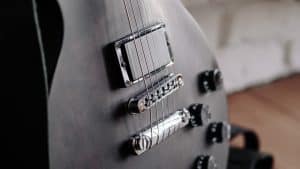A guitar pickup is a cool component of a guitar that creates amazing effects and extends the overall tone of the guitar.
So let’s talk a bit more about it.
Guitar pickups come in various forms (in terms of shapes and sizes). There are different types of guitar pickups. So if you ever want to be a guitar virtuoso someday, then we suggest that you learn about the different types of pickups for guitar.
In the end, you need to have a solid idea about the guitar that you are playing. You need to know how it works and how it helps your guitar to produce that beautiful sound when you put your hands on its strings.
So basically, you need to learn about different types of guitar pickups. That’s the bottom line.
But first of all, what exactly is a guitar pickup?
If you are a guitar enthusiast, you probably know what a guitar pickup is, and you don’t really need an explanation. But let’s talk about it just to make sure that everyone is on the same page here.
Pickups are just magnets where a copper wire is wrapped around. That’s the simplest and easiest way to put it.
What does it do?
Basically, it captures mechanical vibrations produced by the guitar strings and transforms the vibrations into an electrical signal which is then amplified (by using an instrument amplifier) in order to create musical sounds through a loudspeaker. You can also record the signal from a pickup directly.
Types of Guitar Pickups

So, let’s get down to business and talk about these guitar pickups
- Active Pickup
- Passive Pickup
There are so many pickups out there. But eventually, all of them fall under two categories- passive and active. There are different types of pickups for guitar available in the market, and before you try to know about them, you should know something these two common pickups
Passive Pickups
The first pickup that was invented was passive pickups. The reason, why they are called “passive”, is that these pickups do not boost the signal. They don’t need an external power source.
The unique thing about a passive pickup is that its tone is so warm and organic. As a result, these pickups are great for almost everything.
Because of its organic character, purists love these pickups. Compared to active pickups, they are more open-sounding and articulate. Because of that, it can give you a unique musical expression.
Some people though, may have some issues. Some pickups may emit unwanted noise from the multiple coils of wire and that is not a good thing.
Active Pickups
Now, let’s talk about active pickups.
These pickups definitely need a power source. More often than not, you’ll have a 9V battery that is embedded into the guitar.
Back in the ’80s, EMG invented active pickups, and since then, EMG has become one of the best manufacturers of active pickups.
Now, these pickups are not as mainstream as their counterparts. Having said that, they became increasingly popular in the last 3 decades.
By boosting your signal, these pickups give you a higher output. Active pickups will also allow you to boost frequencies from your guitar. It’s a common feature that most acoustic-electric guitars offer.
Usually, in genres like hard rock and metal, active pickups bring that unique tone that is necessary for these genres. Keep in mind that metal and hard rock need a high level of distortion and active pickups are perfect for that.
As an active pickup user, you will find that the tone pots and the volume on your instrument are much more responsive. Having a lower impedance, active pickups prevent the ‘volume roll’ issue.
Electric Guitar Pickups
We are going to talk about three types of electronic guitar pickups here- Single coil, P90, and Humbucker
Single Coil
These coils were the earliest form of guitar pickups. Over the years, they have remained fairly unchanged. When it comes to single-coil pickups, we have to mention Fender. It’s a brand that made a name for itself when it came to producing single-coil pickups.
These pickups use a single magnet, and they produce clear, bright, and spanky sounds. For having only one coil, these pickups are prone to humming.
The great thing about these pickups is that they are suitable for almost any genre. But they are widely used in country music and surf. They have also been used in rock genres successfully.
Humbucker Pickups
Technically speaking, they are two single-coil pickups working together side by side with reversed polarity.
Having two single coils right next to each other makes sure that your guitar produces a big, warm sound. For that reason, these pickups are ideal for jazz.
Because of their higher output, these pickups flourish in genres where high levels of overdrive and distortion are needed.
Having said that, these pickups may not be a good choice when it comes to only genres like country and surf. But in general, they perform pretty well. It will be difficult to find a hard rock or metal player who did not use a humbucker in his life.
In modern humbucker pickups, you’ll get coil-tapping where at the pull of a knob, only one coil will be engaged.
Basically, it makes sure that you get a brighter and cleaner, single-coil sound, which eventually gives you more tonal options.
P90
Introduced after world war 2, the P90 pickup is another type of electric guitar pickup that is widely known.
Technically, P90 pickups are still single coils. However, they are kind of different in terms of construction and sound.
So the real question is- “How are they different?”
The thing is that it has a higher output compared to a typical single-coil pickup. Having said that, it’s not as high as a standard humbucker pickup. Even though p90 pickups are relatively versatile, they are more suited to rockers and punks.
The P90 can be found in different forms:
- Soap Bar
- Dog Ear
- Humbucker Casing
Soap Bar
It’s a rectangular-shaped pickup with mounting screws contained in the middle of the pickup.
Dog Ear
The shape of this pickup is similar to a dog ear pickup. However, the placement of the mounting screws is not in the middle.
Humbucker Casing
It’s similar to a humbucker pickup. But they are a bit longer and thinner than your typical humbucker pickups.
Electric Bass Guitar Pickups
We are done with the Electric Guitar Pickups. But there are so many other pickups that you need to know about. Now we will talk about types of pickups for acoustic guitar. In this case, we are going to talk about J-pickups, Split-Coil pickups, Dual-Coil pickups.
J-Pickups
J for Jazz
Yes, these picks are indeed popular among jazz musicians because of their warm and clear tonality. Having said that, they are not too uncommon in the rock genre.
One more thing you need to know about these pickups is that they were first introduced on Fender’s Jazz Bass.
Split-Coil
Technically these pickups are two halves of a single pickup. If you are a punk or rock musician, then you will be quite fond of it. Because of its punchy tone, this little pickup adds that x-factor that you need in a rock genre.
Dual-Coil
These are mainly humbucking pickups, and like the humbucker pickups, Dual-coil bass pickups have a warmer tone than your typical single-coil pickups.
If anyone is searching for a vintage bass tone, then you can easily suggest these pickups because they will be perfect. However, there is one thing you must keep in mind. These pickups don’t necessarily have the clarity of some of the other pickups we have mentioned.
Acoustic Guitar Pickups
We’ll talk about three types of acoustic guitar pickups: transducer, piezo, and soundhole.
Transducer Pickups
Also known as contact pickups, transducer pickups are one of the most common acoustic pickups. So how does it work?
Basically, these pickups adhere to the instrument’s soundboard. After that, they translate their response into an electric signal. A transducer-based pickup “hear” how the soundboard reacts to the vibration of the guitar strings. So the tone is more reflective of that.
One good aspect of this pickup is that the installation process is really easy and simple. And removing it is even easier.
The issue you may have with this sort of pickup is that it tends to be more sensitive to feedback than the other acoustic pickups.
Piezo Pickups
This pickup is another common acoustic pickup. Pronounced pee-YAY-zoh, these pickups are somewhat similar to transducer pickups, and yet they are a bit different.
Also known as Undersaddle Pickup, a piezo pickup located underneath the bridge saddle(hence the name “Undersaddle” )
The pickup detects vibrations from the saddle. This is where the strings of your guitar are tighter. So the sound is clear and bright.
As we know, these pickups detect vibration exclusively. Plus, they don’t get any sound from the inside of your guitar. As a result, piezo pickups are very resistant to feedback.
So what does that mean?
Well, if you want to play your guitar or show your skills in a massive venue, then these are the pickups you may want to use.
Soundhole Pickups
The word “soundhole” actually suits them perfectly. Why? Because they fit in the soundhole of your guitar(under the strings).
These pickups were introduced in the 1960s, and the best thing about them is that they are easy to install and extremely affordable.
Soundhole pickups are capable of delivering a clear and detailed sound, which is absolutely perfect for flat-picking. The only issue you may find with this pickup is that it creates a slightly artificial tone.
In-Body Microphones
We said that we were going to talk about three types of acoustic guitar pickups. But what’s this? Why are we talking about in-body microphones? They are not even pickups.
Well, the thing is that many companies combine a pickup with an in-body microphone. The combination produces a realistic acoustic tone.
However, there are some downsides as well. More often than not, Microphones are feedback prone(if you compare them to an acoustic guitar).
Other Pickups
Until now, we have talked about mainstream pickups. But there are other variations of these mainstream pickups. Let’s talk a bit more about them-
Z Coil
Just by looking at the term Z Coil, you probably have assumed that it looks like ‘Z’. Well, you are not wrong. Outside it does look like the letter ‘Z’.
Basically, this is a humbucking pickup, and its Z shape gives it a unique tone. If you love classic rock, country, or jazz, then this Z-shaped pickup is indeed perfect for you.
Triplebucker Pickups
Now, this is a pickup that you may not see too often. But we decided to talk about it just because it’s such a great pickup for heavy metal. For us, it’s an ideal pickup if you are into heavy metal.
So why is it called Triplebucker?
Basically, you’ll see three coils in a humbucker size. The main goal here is to create a humbucker that produces a higher output. Furthermore, It produces less noise if you compare it to a typical humbucker.
Gold foil
These pickups are known for their appearances on Silvertone guitars and vintage Supro guitars, and they may come in humbucker or single versions. Perfect for classic rock and blues, these pickups are known for their clear, smooth, and bright high-end sounds.
Filter-Tron Pickups
Technically, it’s another version of humbucker pickups. Loved by players of different genres, these pickups are really popular among those who love jazz, country, and indie rock music.
The conspicuous aspect of these pickups is that they feature two single coils close to each other with a big magnet(bigger than a typical magnet seen on a typical pickup).
Because of its design, it produces a brighter and less warm tone compared to other humbucker pickups while minimizing the hum.
Toaster Pickups
Lastly, we will talk about the toaster pickup.
Also known as Rickenbacker pickups, these pickups are perfect if you are into pop, classic rock, or indie rock. These vintage single and double coil pickups are responsible for producing some of rock’s greatest hits.
Final Word
So we have talked about some of the most well-known pickups that you can find. Keep in mind that there many other pickups that we haven’t talked about. To be honest, it’s almost impossible to talk about all of them because there are so many of them.
Despite that, we have done our best to make sure that you learn about the most popular ones that are widely used all over the world.



